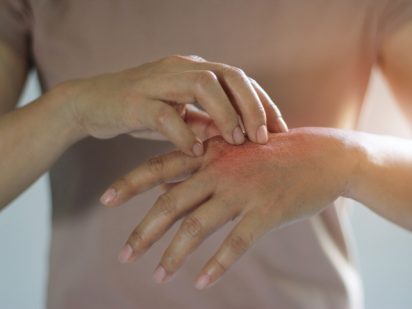Psoriasis is an auto-immune disease in which the immune system mistakes a normal skin cell for a pathogen and sends out faulty signals that cause an overproduction of new skin skills. This is characterized by the skin getting thickened and topped with white scales.
“The body is building layers of skin cells on top of one another, and that’s when the skin becomes thickened and forms the white scales,” explained Ann Welch, FNP-C, with Trinity Health’s Dermatology department.
According to the National Psoriasis Foundation, more than 8 million Americans – and 125 million people worldwide, or 2 to 3 percent of the total global population – have psoriasis.
Psoriasis can be genetic, as a child has about a 10 percent chance of having psoriasis if at least one parent has it, the Foundation’s website said. “If both parents have psoriasis, a child has approximately a 50 percent chance of developing the disease.”
“The cause of psoriasis isn’t fully understood, but it’s thought to be related to an immune system problem with T cells and other white blood cells, called neutrophils, in your body,” Mayo Clinic said on their website. “T cells normally travel through the body to defend against foreign substances, such as viruses or bacteria. But if you have psoriasis, the T cells attack healthy skin cells by mistake, as if to heal a wound or to fight an infection.”
There are four types of psoriasis:
- Guttate – This is sometimes preceded by strep throat. Guttate psoriasis is usually characterized as small, red dots on the skin of arms, legs, and trunk.
- Inverse – This involves smooth, dry patches that are red and inflamed, often in the folds or creases of the skin, such as in the armpits or groin, between the buttocks, or under the breasts.
- Pustular – Blister-like spots filled with fluid, surrounded by red skin. The blisters often come and go in cycles. This form of psoriasis can appear on specific areas, like the hands or feet, or on larger areas of skin.
- Erythrodermic – Intense inflammation with bright, red skin that looks ‘burned’ and sheds or peels. About 10 to 30 percent of people with psoriasis also get psoriatic arthritis, which causes pain, stiffness, and swelling in and around the joints. The hands, feet, wrists, ankles, and lower back are most often affected by this type of arthritis.
There are a variety of treatment options available for those with psoriasis, including a new Janus kinase (JAK)-inhibitor, an oral pill which is a more specific pathway to treat psoriasis, Welch explained. The JAK-inhibitor serves as a narrow scope to get “into our immune system to tell the psoriasis to quit the inflammation process,” she said. “The JAK-inhibitors tell your body’s immune system to stop making the janus kinase enzymes that cause people to develop autoimmune diseases, such as psoriasis.”
Other forms of therapy include biologic drugs (Humira, Enbrel, Costentyx, Taltz, Stelera, Tremfyz, Skyrizi), methotrexate, acitretin, topic steroids, calcipotriene, tazarotene, tar-based preparations, and light therapy, Welch noted.
Biologic drugs, or biologics, are a protein-based drug derived from living cells cultured in a laboratory, the National Psoriasis Association explained on its website. “The biologics used to treat psoriatic disease block the action of a specific type of immune cell called a T cell, or block proteins in the immune system, such as tumor necrosis factor-alpha (TNF-alpha), interleukin 17-A, or interleukins 12 and 23. These cells and proteins all play a major role in developing psoriasis and psoriatic arthritis.”
Biologics are usually administered by injection or intravenous (IV) infusion.
Another form of therapy is light therapy, which is also available at Trinity Health. The light booth uses UVB rays and narrow band UVB technology, which help to combat psoriasis.
If you think you may have psoriasis, please contact your primary care provider.

